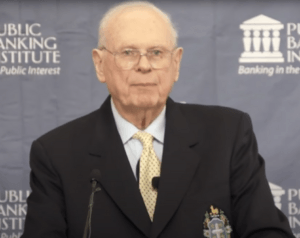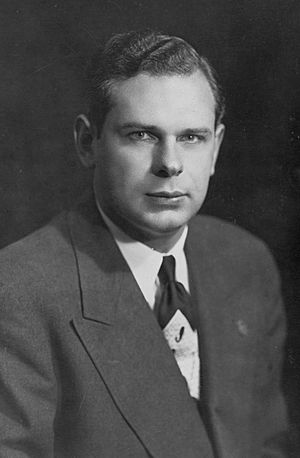Paul Hellyer facts for kids
Quick facts for kids
Paul Hellyer
|
|
|---|---|

Hellyer speaking at the Public Banking In America conference in April 2012
|
|
| Minister of Transport | |
| In office September 19, 1967 – April 30, 1969 |
|
| Prime Minister | Lester B. Pearson Pierre Trudeau |
| Preceded by | Jack Pickersgill |
| Succeeded by | James Armstrong Richardson |
| Senior Minister | |
| In office April 30, 1968 – April 23, 1969 |
|
| Prime Minister | Pierre Trudeau |
| Preceded by | Office established |
| Succeeded by | Vacant |
| Minister of National Defence | |
| In office April 22, 1963 – September 18, 1967 |
|
| Prime Minister | Lester B. Pearson |
| Preceded by | Gordon Churchill |
| Succeeded by | Léo Cadieux |
| Member of Parliament for Trinity |
|
| In office December 15, 1958 – July 7, 1974 |
|
| Preceded by | Edward Lockyer |
| Succeeded by | Aideen Nicholson |
| Member of Parliament for Davenport |
|
| In office June 27, 1949 – June 9, 1957 |
|
| Preceded by | John Ritchie MacNicol |
| Succeeded by | Douglas Morton |
| Personal details | |
| Born |
Paul Theodore Hellyer
August 6, 1923 Waterford, Ontario, Canada |
| Died | August 8, 2021 (aged 98) Toronto, Ontario, Canada |
| Political party | Canadian Action Party (1997–2017) |
| Other political affiliations |
Liberal (1949–1971, 1982–1997), Independent (1971), Action Canada (1971–1972), Progressive Conservative (1972–1982) |
| Spouses | Ellen Jean Hellyer (d.2004); Sandra Hellyer (m.2005) |
| Children | 2 sons, 1 daughter |
| Residence | Toronto |
| Profession | Engineer |
| Military service | |
| Branch/service | |
| Years of service | 1939–1946 |
| Rank | |
| Unit | Royal Canadian Artillery |
Paul Theodore Hellyer (born August 6, 1923 – died August 8, 2021) was an important Canadian figure. He was an engineer, a politician, a writer, and a speaker. He served Canada for a very long time. In fact, he was the longest-serving member of the Queen's Privy Council for Canada when he passed away. This council advises the Queen's representative in Canada.
Contents
Paul Hellyer's Early Life
Hellyer grew up on a farm near Waterford, Ontario. After high school, he studied aeronautical engineering in California. He graduated in 1941 and also earned a private pilot's license.
During World War II, Hellyer worked at Fleet Aircraft. This company made training planes for the Royal Canadian Air Force. He wanted to be a pilot, but was told they had enough. So, he joined the Royal Canadian Artillery and served as a gunner in Canada during the war. In 1949, he earned a Bachelor of Arts degree from the University of Toronto.
Starting a Political Career
Paul Hellyer was first elected as a Liberal politician in 1949. He represented the area of Davenport. At that time, he was the youngest person ever elected to the House of Commons of Canada.
He briefly worked as an assistant to the Minister of National Defence. Later, he became the Associate Minister of National Defence. However, he lost his seat in the 1957 election.
Hellyer returned to Parliament in 1958, winning a special election in the Trinity area. He became a strong voice against the government of Prime Minister John Diefenbaker.
Becoming a Cabinet Minister
When the Liberals won the 1963 election, Hellyer became the Minister of National Defence. This was a very important time in his career.
As Defence Minister, he led a big change. He combined Canada's three military branches: the Royal Canadian Navy, the Canadian Army, and the Royal Canadian Air Force. They all became one group called the Canadian Forces. This was a major and sometimes debated decision.
In 1968, Hellyer ran to become the leader of the Liberal Party. He came in second on the first vote. He then supported Robert Winters, but Pierre Trudeau eventually won the leadership. Hellyer then served as Trudeau's Minister of Transport.
Changes in Politics (1969–1988)
In 1969, Hellyer wrote an important report about housing and city planning. He suggested small changes to improve housing, rather than creating big new government programs. He wanted banks to be more flexible with home loans. He also encouraged pension funds to invest in housing.
His report also said that old houses should not be torn down without careful thought. He believed that large city renewal projects should stop. Hellyer left the government in 1969 because he disagreed with Prime Minister Trudeau about how to put his housing ideas into action.
After leaving the government, Hellyer served in Parliament as an independent politician. In 1971, he tried to start a new political party called Action Canada, but it did not succeed. Then, Progressive Conservative leader Robert Stanfield invited him to join their party.
Hellyer was re-elected as a Progressive Conservative in 1972. However, he lost his seat in the 1974 election.
In 1976, Hellyer ran for the leadership of the Progressive Conservative party. His ideas were considered too conservative by many. He finished sixth in the race, and Joe Clark became the leader.
Hellyer rejoined the Liberal Party in 1982. He mostly stayed out of the spotlight. In 1988, he tried to run for Parliament again in Toronto, but he lost.
Under Prime Minister Pierre Trudeau, Hellyer also held the special role of Senior Minister from 1968 until he resigned in 1969.
Canadian Action Party
In 1997, Paul Hellyer started a new political party called the Canadian Action Party (CAP). He believed that Canada needed a party focused on its own economy. He felt that the other major parties were too focused on globalization.
Hellyer's party also supported his ideas about money. He thought the government should create more of the country's money. He wanted to change the system so that public money creation was equal to private money creation.
The Canadian Action Party remained a small party. Hellyer ran for Parliament in 1997 and 2000 but did not win a seat.
After the 2000 election, Hellyer suggested that his party merge with the New Democratic Party. However, the New Democratic Party did not agree to the merger, especially because it would have meant changing their name. Hellyer then stepped down as the leader of the Canadian Action Party, but he remained a member.
Views on Extraterrestrial Life
On June 3, 1967, Paul Hellyer helped open a special landing pad for UFOs in St. Paul, Alberta. The town built it to celebrate Canada's 100th birthday. It was also a symbol of keeping space peaceful. A sign there welcomes all visitors from Earth or space.
In 2005, Hellyer made news by saying he believed in UFOs. He spoke at a conference and shared that he had seen a UFO with his late wife and friends. He said he started taking the idea more seriously after watching a TV show about UFOs.
In 2007, a newspaper reported that Hellyer wanted governments to share what they know about alien technology. He believed this technology could help solve climate change. He said, "We need to persuade governments to come clean on what they know. Some of us suspect they know quite a lot, and it might be enough to save our planet if applied quickly enough."
In a 2014 interview, Hellyer stated that at least four types of aliens have visited Earth for thousands of years. He said most come from other star systems, but some live on Venus, Mars, and Saturn's moon. According to him, these visitors "don't think we are good stewards of our planet."
Personal Life
Paul Hellyer was one of the first people to invest in the Toronto Sun newspaper in 1971. He also wrote columns for the newspaper from 1974 to 1984.
Hellyer lived in Toronto. He had three children and five grandchildren. He passed away on August 8, 2021, two days after his 98th birthday, due to complications from a fall.
Images for kids
See also
 In Spanish: Paul Hellyer para niños
In Spanish: Paul Hellyer para niños



